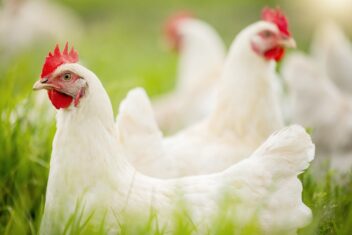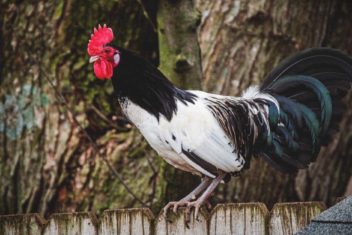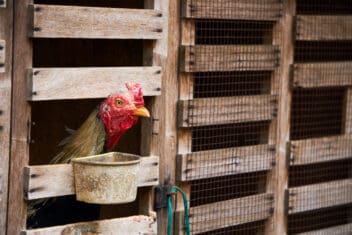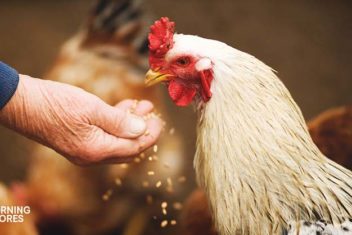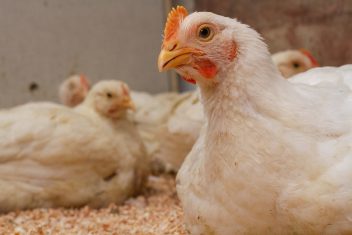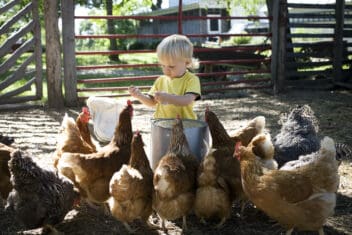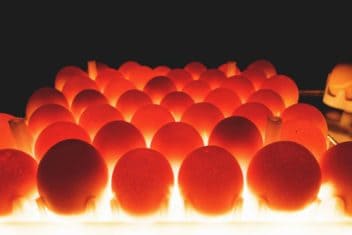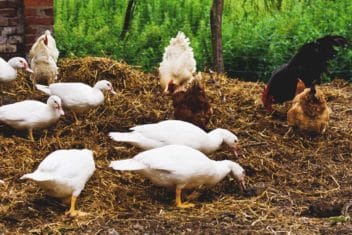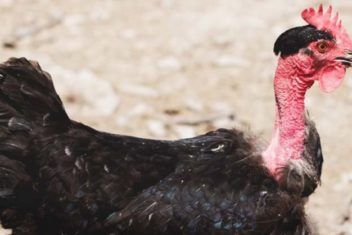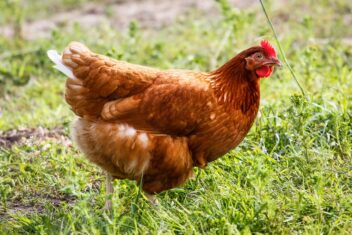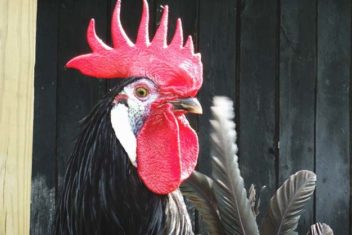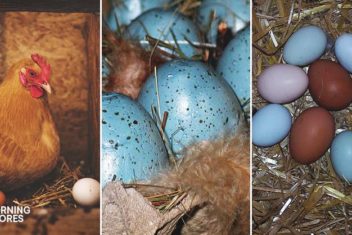Raising your own chickens has many advantages. They produce eggs and entertainment for days.
Feeding your chickens can get rather costly if you depend upon the local feed stores to do the job. That is why learning how to find cheap chicken feed or raising your own can be vital in raising chickens.
It also shows you one more great advantage to raising chickens: they are little garbage disposals.
1. Fodder
Fodder is nothing more than soaking and sprouting seeds. It is so easy yet so cost-effective. You can sprout many different kinds of seeds, but my personal favorite is wheat.
You can usually get a 50lbs bag of wheat for around $8-$9. This will produce around 400lbs of food for your chickens.
Start by soaking wheat seeds in a container for 12-24 hours. Then place them in a tub with holes drilled for drainage.
Water the seeds daily and within 7 days you’ll have chicken feed.
Soak seeds daily so the fodder stays on a 7-day cycle. Fodder can be grown outdoors in warmer temps or indoors year-round. I actually grow mine in my living room.
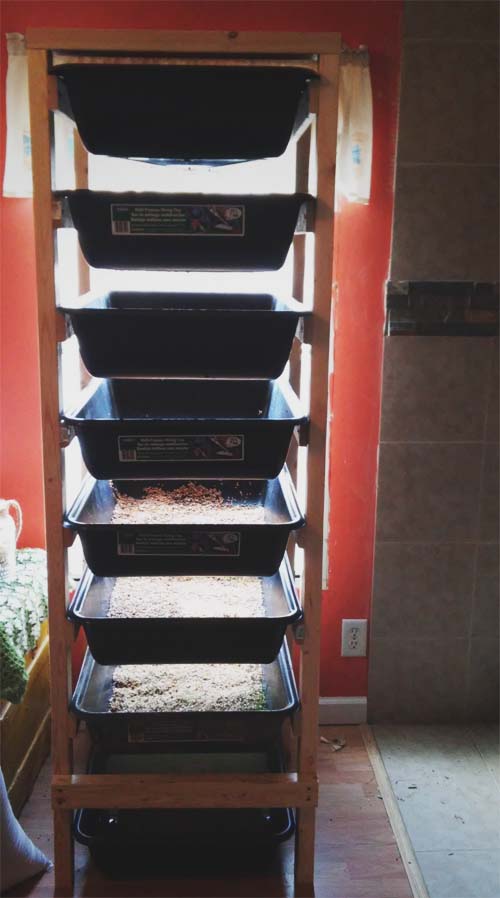
You can build your own fodder system. It is very cost-effective and provides everything that your chickens need.
2. Weeds and Lawn Clippings
Yard clippings are great chicken food.
When mowing your grass, save the yard clippings and feed them to your chickens. You can also save and reuse the weeds from your vegetable garden and flower beds as chicken feed.
Chickens are the perfect animals to stop wasting anything. This is just one more way to put waste to good use.
3. Hearty Greens and Root Vegetables
Hearty greens like turnip greens, kale, sorrel, swiss chard, and leaf lettuce can be grown practically all year long. This equates to great and practically free chicken feed.
Any type of hearty greens can be grown outdoors during most of the year.
If you have a cold frame greenhouse, they can be grown during the coldest of temps without electricity.
Root vegetables are also cold resistant and can be grown throughout the year. Chickens love carrots, parsnips, onions, and other root vegetables. They especially appreciate the burst of vitamins they receive from freshly grown vegetables during the cold winter months when they are lacking the extra hours of sunlight.
Here is a great way to grow duckweed and water hyacinth for your chickens so they can’t scratch up the seeds!
4. Deer Corn
When deer corn is in season we buy it locally. We then take it home and run it through our wood chipper. This gives us inexpensive cracked corn to feed to our chickens.
Corn mixed with some of the above options should give your birds a cheap balanced diet without making them overweight.
5. Kitchen Scraps
Some frown upon feeding their chickens table scraps, but my birds love them!
As soon as they see my compost pail they start running towards it. Chickens will eat almost all table scraps, but I do not feed mine meat.
Feeding your chickens from the table keeps food from going to waste as well as keeping your chickens fed with no extra cost. Just use portion control so your birds do not develop a weight problem.
6. Garden Leftovers
When gardening, you often have vegetables or fruits that go bad before they get picked or are just not what you would like to eat or can.
That’s okay! Feed these seconds to your chickens.
Chickens will eat almost any vegetable or fruit out of your garden. Since they are foragers, they will not only eat the fruit of your plant but if you have weaker plants you can feed them to your chickens too.
7. Their Own Egg Shells
Your chickens can give you eggs but don’t waste their eggshells. Grind them up and feed them back to them! Chickens require calcium to produce eggs with hard shells.
By feeding them their own shells, it helps keep their calcium levels up.
Their eggshells can be mixed in with any of the above options for a much-needed calcium boost and once again, at no extra cost to you.
Mix in some apple cider vinegar or garlic into their water and your chickens will have all of the vitamins they need to be happy healthy layers.
Feeding eggshells to chickens won’t bring any negative effect, but you still have to feed them with other sources of calcium like an oyster shell from time to time. Diatomaceous earth can also be a good supplement, although there is some debate about whether diatomaceous earth for chickens is good or bad.
8. Sunflowers
Chickens love sunflowers and their seeds.
I never knew this until I experimentally grew sunflowers next to the chicken coop last year. My sunflowers grew amazingly well because of all of the natural fertilizer and my chickens had fun trying to jump and eat the sunflowers as they drooped over from their size.
Feeding your chickens sunflowers can be accomplished in two ways: by growing sunflowers or buying oiled sunflower seeds. You can buy oiled sunflower seeds in big bags.
They can be sprouted and used as fodder or fed to the chickens straight.
If you choose to grow your own sunflowers, you can cut off the heads of the sunflowers when fully grown.
You then can hang them somewhere dry (i.e. barn, covered shed, building) and then toss the whole sunflower head to your chickens each day.
9. Fermented Grains
Fermenting grains is the first step to growing fodder. However, if you don’t want to create your own fodder system, you don’t have to. Instead, you can still buy wheat seeds (or any other inexpensive grain) and soak them in water overnight.
That is all there is to fermenting your own grains.
There are many health benefits to feeding your chickens fermented grains. Just as importantly, this method saves you money.
When feeding chickens scratch grains, they do just that…scratch…all through the grains. A lot of your feed ends up on the coop floor. When you ferment your grains they also are less likely to scratch through it and waste food.
Purchasing wheat seed to ferment can usually be purchased locally for less per 50lb bag in comparison to store-bought scratch feed.
Fermented grain is also known to strengthen chicken’s eggshell consistency.
High Protein Feed Supplements
Your chickens need protein more than anything. While some of the options above are high in protein already, you might need to add any of the options below to your homemade feed to make it more nutritious.
Some items on this list can cost a bit higher or hard to get on a daily basis compared to the options above, which is why I call them supplements. You can mix protein supplements below with any of the regular feed options and you’ll get the ultimate homemade chicken feed.
10. Mealworms
Mealworms are another food that can be grown right in your living room and no one would even know it. You purchase mealworms by the poundage from local or online retailers.
Place them in oats, with potato or carrot for water, and then they reproduce.
They can be grown under the bed boxes or in a 3-tier plastic shelving system. Both of these methods allow you to grow food for your chickens discretely.
This is a great source of protein for your chickens and practically free for you. Check out this article on how to get started raising mealworms!
11. Camelina Meal
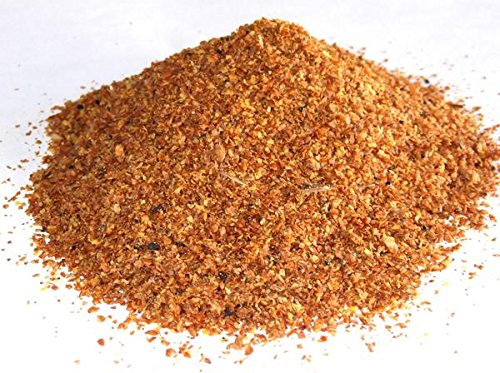
Camelina Meal is an old, old crop that was used for many years. It is super high in Omega-3s and is included in many livestock feeds because of how it provides such a protein boost to livestock.
This is a rather high commodity item so it costs a bit more per pound. However, if you are after high nutrition for your birds and price doesn’t play a factor, then this could be a great protein substitute for you.
12. Cottonseed Meal
Cottonseed meal is what is left after the cotton has been ginned and the seeds have had all of the oil extracted out of them. The remains get fed to livestock as a protein boost.
If you happen to live where there is a cotton farm nearby (I grew up near one. They are gorgeous!) you could potentially strike up a deal there and get your own cotton meal for less money.
You can also buy cottonseed and make your own cottonseed meal. However, remember, cottonseed meal is also used as a fertilizer so this is one you’ll want to use caution when feeding to your chickens due to toxicity.
13. Earthworms

Earthworms are wonderful little creatures. If your birds are free-range then they probably eat their fair share of these. This is a good thing as they pack a lot of protein.
However, even if they don’t free range you can raise your own to feed your birds plus a little extra to make some income. Here is how to build a worm farm.
14. Flaxseed Meal
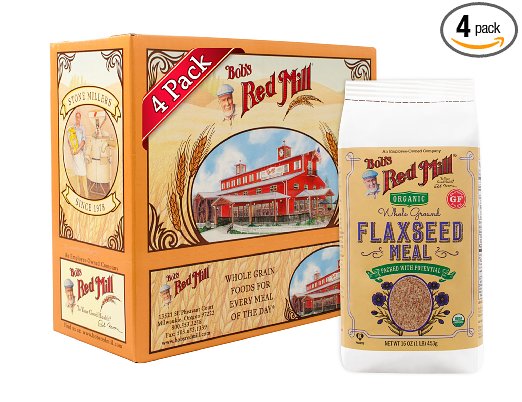
Flaxseed is a good ingredient to add to your own meals because of the added fiber and healthy fats. So it shouldn’t surprise you that flaxseed meal is also a good protein boost for your chickens.
You can purchase flaxseeds and grind them up with a spice grinder, or you can purchase an actual flaxseed meal. Either way, adding a little to your chickens’ feed will hopefully give them that added protein boost that layer feed does.
15. Lupin Bean
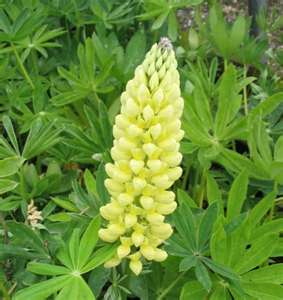
Lupin is a flowering plant that grows in poor soil that has too much acid. They are actually quite common in Australia, and they belong to the legume family.
However, why people love them so much is that they can be fed straight to chickens without having to be ground. So if you have an area of your land that won’t grow much, you could potentially plant these flowers and then use them as chicken feed. They are pretty, too.
16. Peanut Meal
While they have a good amount of protein, peanut meal is another chicken feed option that you need to use caution with if there’s someone with peanut allergy in your family. Scientists still aren’t sure if the feed passes through to the egg. This would only be an issue if you or someone you cook for are allergic to peanuts or if you sell your eggs which could potentially open them up to someone with an allergy.
So again, I offer caution in using this as a protein supplement. Peanut meal is actually a hard thing to get your hands on, but if you are lucky enough to then you might want to consider using it for your birds.
17. Potato Protein
When you make potato starch, the potato protein is what is left over after the starch is made. Potato starch is used a lot in Europe in the place where others might use corn starch.
If you use potato starch or know someone that does, you could potentially have a great protein source for your flock.
18. Safflower Meal
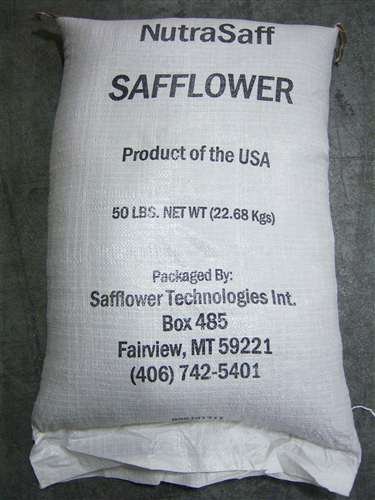
Safflower is what is used to make vegetable oil. The meal for this is very similar to a cottonseed meal. Basically, when they’ve gotten everything out of the plant, they take what is left and grind it into a fine powder or meal.
Also, this is an annual plant. However, it contains a lot of thistles so you might not want to have it growing around your property. If not, you can always purchase it.
19. Sesame Seed Meal
Do you ever cook with sesame seed oil? Well, then you’ve been involved in the process of making a sesame seed meal.
Basically, after they get all that they can out of this plant by extracting oil from it, then they grind what is left into a powder. This powder could potentially be a good protein source for your flock.
20. Legume Seeds
Legumes have a lot of protein. We know this because we are told to eat them for the exact same reason. So if you have any seeds left over after planting your legumes then feed them to your flock. They’ll love the treat and the protein.
21. Maggots
This may sound disgusting but if you have maggots around, don’t toss them out. Instead, use them for chicken feed.
I say this because they are packed full of protein. Go ahead and scrape up those maggots and give your chickens what their bodies need.
22. Fish and Their Guts
Do you do fish farming? Do you go fishing? If you answered yes to either of these then you have a great source of protein on your hands.
See, you can not only feed them the fish (even the bottom feeders that you usually throwback), but you can also feed them the guts of the fish that you keep for yourself. This is a good source of protein and a potentially inexpensive option as well.
23. Animal Meat, Guts, and Organs
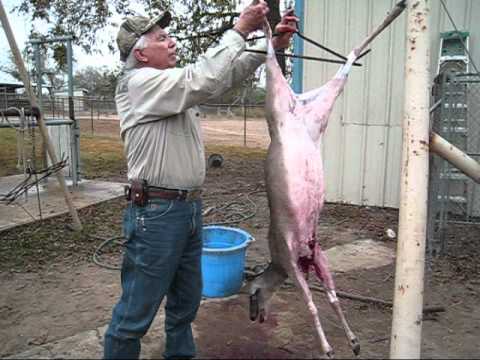
It is deer hunting season in our area. Thankfully, we’ve been putting deer away already this year. My chickens are happy too.
However, probably not as much as I am. The reason is that I can feed them the scraps of the deer that I don’t use. Plus, I can give them the guts and organs for a great source of protein. This is a cheap protein chicken feed option and one that also fulfills their nutritional needs.
24. Road Kill
I passed a deer that had been run over a few days ago. I seriously thought about stopping and picking it up. You’re probably thinking, “Why?”
Well, because it is free chicken food and a lot of it. The next time you see roadkill, don’t pass it up. Instead, take it home and freeze it for your birds.
25. Dehydrated Eggs
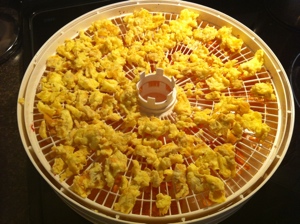
When you have chickens there are certain times of the year that you are absolutely run over in eggs. If not, give them a little extra protein and see if that improves things.
However, you can dehydrate these eggs and then feed them sporadically to your chickens for a great source of protein throughout the year.
26. Seeds Found in Food Scraps
Do you ever cut up fruits and vegetables and have a mess of pulp and seeds on your counter? I know I do every time I cut cantaloupe or pepper.
Well, don’t toss the mess. Instead, gather it up and use it for chicken feed. Those seeds are actually great for them! Who knew, right?

